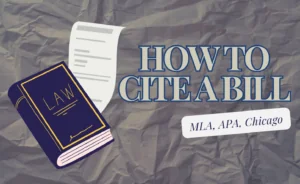When writing research papers or academic essays, it’s generally advisable to avoid citing secondary sources, often referred to as “indirect” quotations. Ideally, you would always cite directly from primary sources, telling your readers and teachers that your arguments are built on rock-solid foundations. However, life as a student isn’t always filled with perfect scenarios. Sometimes the only trace of some piece of information is tucked away in the citation of another author’s work.

✅ AI Essay Writer ✅ AI Detector ✅ Plagchecker ✅ Paraphraser
✅ Summarizer ✅ Citation Generator
Why To Cite A Quote Within A Quote
Maybe the original document is lost in the depths of out-of-print books or hidden behind a paywall thicker than a medieval fortress. When you find yourself in such a bind, citing a quote within a quote becomes a necessity (and a headache). While it may initially seem as intimidating as decoding an ancient manuscript, fear not—it’s far simpler in practice. You need to acknowledge the original source in the body of your text, clearly stating that your encounter with this source was through another author. Then, you list the secondary source—the one you actually consulted—in your reference list. This way you keep your academic integrity intact and your paper transparent.
The most frequent explanations for why students might need to reference an indirect quote are listed in the table below. Look it over, and perhaps one of those situations will fit your case:
| Inaccessibility of the Original Source | The original material might be out of print, archived in a non-digital format, or housed in a location that is inaccessible due to geographic or financial constraints. |
| Original Source is in a Foreign Language | Sometimes the primary source may be in a language the researcher does not understand, and the only available translation is quoted in another researcher’s work. |
| Rare or Fragile Documents | Certain primary sources might be rare, fragile, or preserved in such a way that public access is restricted to protect the document, making secondary sources the only viable option. |
| Legal Restrictions | Copyright laws or privacy regulations might restrict access to the original source. Secondary sources that summarize or quote the original work can be an alternative. |
| Time Constraints | In some academic or professional scenarios, time constraints might prevent extensive primary research, leading researchers to rely on comprehensive secondary analyses. |
| Citation of a Citation | The original author might have cited another work that is relevant to the current research. If this cited work is central to the argument, but not directly accessed, a secondary citation is necessary. |
| Historical Context Provided by Secondary Sources | Secondary sources often provide necessary historical or critical analysis that is not available from the primary source alone. |
| Expert Interpretation | Sometimes, secondary sources offer expert interpretations of primary data that are essential for understanding complex ideas or contexts. |
How To Cite A Quote Within A Quote
When you cite a quote within a quote, you are threading a needle through piles or pages of scholarly work, connecting ideas and honoring the original thoughts of authors both directly and indirectly related to your research. This process provides a clear trail back to the original source of the information and keeps you safe from plagiarism.
There is an alternative easy way to make a citation: our free Reference Citation Generator comes to the rescue!
Regardless of the style you’re adhering to (APA, MLA, or Chicago), the fundamentals of citing a quote within a quote remain largely the same. The goal is to make clear to your readers the journey an idea took from the original thinker to your paper. This involves acknowledging the secondary source you directly consulted while noting how it references the primary material. This layered acknowledgment improves the academic dialogue, inviting others to explore further, confirming your findings, or even challenging them with new insights.
APA
In APA style, when you need to cite a quote within a quote—known as a secondary source citation—you must clearly distinguish between the source you actually read and the source that was originally cited. This method helps maintain clarity and provides the reader with an understanding of the sources’ origins.
Steps of the citation process:
- In-text Citation: Mention both the original and the secondary sources in the text. Clearly indicate that your direct source mentioned the original work.
- Reference Entry: In your reference list, you only include the secondary source, as this is the source you have accessed and read directly.
In-Text Citation Format: In the narrative of your text, you would structure your sentence like this: (Original Author, as cited in Secondary Author, year).
Suppose you are citing a statement from Freud that you found in a book by Jones. You would write:

Reference Entry Format: List the secondary source in your reference list as per usual APA format: Author of Secondary Source. (Year). Title of the work. Publisher. DOI or URL (if applicable).

MLA
MLA style also requires clear distinction when citing a secondary source. This involves citing the original source within your text and listing only the secondary source you actually read in your Works Cited list.
Steps of the Citation Process:
- In-text Citation: Incorporate both the original author and the secondary source within the parenthetical citation. The citation should make it clear that the original source is being cited through another source.
- Works Cited Entry: Include only the secondary source in your Works Cited list, as this is the source you directly accessed.
In-Text Citation Format: In your text, use this format: (qtd. in Secondary Author Last Name, page number).
If you are citing a statement by Shakespeare that you found in a study by Green, you would write:

Works Cited Entry Format: Structure the entry for the secondary source in your Works Cited list as follows: Secondary Author Last Name, First Name. Title of the Work. Publisher, Year of publication.

Chicago
Chicago style is commonly used in historical and academic publications. It also offers clear guidelines for citing secondary sources. Like other styles, it requires precise acknowledgment of both the original and the secondary sources within the text, while the bibliography only includes the secondary source.
Steps and Elements of the Citation Process:
- In-text Citation: Mention the original author directly in your text and include a citation for the secondary source within a footnote or endnote.
- Bibliography Entry: Include only the secondary source in the bibliography, as this is the source you have directly accessed.
In-Text Citation Format: Mention the original author in the text of your document and add a citation footnote or endnote at the end of the sentence: (see Secondary Source, page number).
If you are discussing a concept by Durkheim that you found in a book by Smith, you could write:

Then, in the footnote, you would add: 1 Smith, Sociological Perspectives, 34.
Bibliography Entry Format: The secondary source should be listed as follows: Secondary Author Last Name, First Name. Title of the Work. Place of Publication: Publisher, Year of publication.

As you can see, there isn’t anything impossible. Yes, there is an additional step in each citation style discussed, as you basically need to refer to two authors. Nevertheless, there’s nothing fundamentally groundbreaking. Just make sure where and which author to include in your work, and you’ll be alright!
FAQ
Follow us on Reddit for more insights and updates.





Comments (0)
Welcome to A*Help comments!
We’re all about debate and discussion at A*Help.
We value the diverse opinions of users, so you may find points of view that you don’t agree with. And that’s cool. However, there are certain things we’re not OK with: attempts to manipulate our data in any way, for example, or the posting of discriminative, offensive, hateful, or disparaging material.